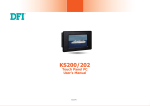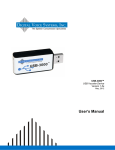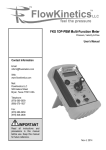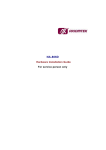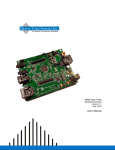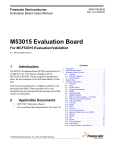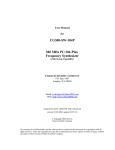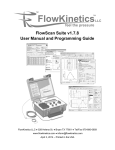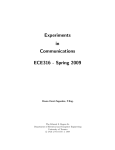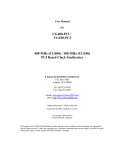Download Digital Voice Systems VC-55-PR User`s manual
Transcript
Digital Voice Systems, Inc. The Speech Compression Specialists VC-55™-PR Voice Codec Board User’s Manual Version 1.3 February 2015 VC-55™-PR Voice Codec Board User’s Manual Version 1.3, February 2015 Copyright, 2005 Digital Voice Systems, Inc 234 Littleton Road Westford, MA 01886 This document may not, in whole or in part be copied, photocopied, reproduced, translated, or reduced to any electronic medium or machine readable form without prior consent in writing from Digital Voice Systems, Incorporated. Every effort has been made to ensure the accuracy of this manual. However, Digital Voice Systems, Inc. makes no warranties with respect to the documentation and disclaims any implied warranties of merchantability and fitness for a particular purpose. Digital Voice Systems, Inc. shall not be liable for any errors or for incidental or consequential damages in connection with the furnishing, performance, or use of this manual or the examples herein. The information in this document is subject to change without notice. Trademarks VC-55™-PR Voice Codec Board, AMBE+2™ and AMBE+™ are trademarks of Digital Voice Systems, Inc. AMBE® is a registered trademark of Digital Voice Systems, Inc. Other product names mentioned may be trademarks or registered trademarks of their respective companies and are the sole property of their respective manufacturers. Windows 200/XP/Server, Windows 98/Me are trademarks of their respective owners. All Rights Reserved Data subject to change VC-55™- PR Voice Codec Board END USER License Agreement 1. Preliminary Statements and Definitions 1.1 This nonexclusive end user product license agreement is a legal agreement between the customer (the END USER) and Digital Voice Systems, Inc. (DVSI) covering the terms and conditions under which DVSI's proprietary content (that may consist of and is not limited to software, hardware, documentation and other material) is licensed to the END USER as part of this PRODUCT. a) The PRODUCT shall mean the Hardware, Software, Documentation and other materials that were provided by DVSI, either directly or indirectly through distributors or agents, to END USER as part of a sale, delivery or other transaction. b) Hardware can be in the form of Integrated Circuits (such as Digital signal Processors) Circuit boards and electronics enclosed in a chassis. DVSI’s Net2000™ VCU is an example of electronics enclosed in a chassis. c) Software can be in form of computer code, firmware masked into an IC or stored or embedded into ROM or RAM or Flash memory, or software stored on any media (such as CD-ROM, floppy disk, hard drive, solid-state memory or the Internet) d) Documentation means written or electronic information, including user manuals, technical documents, training materials, specifications or diagrams, that pertain to or are delivered with the PRODUCT in any manner (including in print, on CD-ROM, or on-line). 1.2 DVSI has developed a number of voice coding methods and algorithms (the “Technology”) which include DVSI’s Advanced Multi-Band Excitation (“AMBE”) , AMBE+™, and AMBE+2™ voice coders. The Technology codes speech at low bit rates and may include error correction, echo cancellation and other auxiliary functions. 3.1 The END USER shall have the right to transfer the rights under this Agreement to a third party by either (i) providing the third party with a copy of this Agreement or (ii) providing the third party with an agreement written by the END USER ( hereinafter “END USER Agreement”) so long as the END USER Agreement is approved in writing by DVSI prior to transfer of the PRODUCT. The END USER Agreement shall contain comparable provisions to those contained herein for protecting the Proprietary Information from disclosure by such third party. Third parties shall agree to accept all the terms and conditions under either Agreement or the END USER Agreement. 4. Term and Termination 4.1 This Agreement is effective upon initial delivery of the PRODUCT and shall remain in effect until terminated in accordance with this agreement. 4.2 This Agreement shall terminate automatically without notice from DVSI if END USER fails to comply with any of the material terms and conditions herein. END USER may terminate this Agreement at any time upon written notice to DVSI certifying that END USER has complied with the provisions of Section 3. 4.3 Upon termination of this Agreement for any reason, END USER shall: (i) return the PRODUCT and documentation purchased or acquired, or in Licensee’s possession, to DVSI; (ii) have no further rights to any DVSI Software or the Technology without a separate written license from DVSI; (iii) discontinue all use of the PRODUCT; All confidentiality obligations of Customer and all limitations of liability and disclaimers and restrictions of warranty shall survive termination of this Agreement. In addition, the provisions of the sections titled "U.S. Government End User Purchasers" and "General Terms Applicable to the Limited Warranty Statement and End User License" shall survive termination of this Agreement. 5. Payments 1.3 "DVSI Voice Compression Software" shall mean the voice coding Software that implements or embodies the Technology and is embedded into or otherwise provided with the PRODUCT. 1.4 "DVSI Voice Codec" shall mean the DVSI Voice Compression Software, any PRODUCT Hardware into which the DVSI Voice Compression Software is embedded or executed and any associated Documentation. 1.5 DVSI represents that it owns certain “Proprietary Rights” in the PRODUCT including patent rights, copyrights, trademarks and trade secrets. These rights include one or more of the following US Patents #5,630,011; #5,649,050; #5,701,390; #5,715,365; #5,754,974; #5,826,222; #5,870,405; #6,161,089; #6,199,037; #6,912,495; #7,634,399; #7,957,963; #7,970,606; #8,036,886; #8,200,497; #8,315,860 and #8,359,197; and under other US and foreign patents and patents pending. AMBE, AMBE+™ and AMBE+2™ are trademarks of Digital Voice Systems, Inc. 1.6 “END USER” shall mean the person and/or organization to whom the DVSI Vocoder Product (software or hardware) was delivered or provided to as specified in the purchase order or other documentation. In the event that the END USER transfers his rights under this license to a third party as specified in Section 3.0, then this third party shall become an “END USER”. 1.7 DVSI reserves the right to make modifications and other changes to its products and services at any time and to discontinue any product or service without notice. 2. License Granted 2.1 Subject to the conditions herein and upon initial use of the DVSI Product, DVSI hereby grants to END USER a non-exclusive, limited license to use the DVSI Voice Compression Software and Technology within the PRODUCT. No license is granted for any use of the DVSI Voice Compression Software or Technology on any other device or Hardware or in any manner other than within the original unmodified PRODUCT purchased from DVSI. No license is granted to copy or modify the DVSI Voice Compression Software or the PRODUCT either in whole or in part. 2.2 No license, right or interest in any trademark, trade name or service mark of DVSI is granted under this Agreement. END USER acknowledges that the PRODUCT may contain trade secrets of DVSI, including but not limited to the specific design, and associated interface information. 2.3 END USER shall not copy, extract, reverse engineer, disassemble, decompile or otherwise reduce the DVSI Voice Compression Software to human-readable form. END USER shall not alter, duplicate, make copies of, create derivative works from, distribute, disclose, provide or otherwise make available to others, the DVSI Voice Compression Software and Technology and/or trade secrets contained within the PRODUCT in any form to any third party without the prior written consent of DVSI. The END USER shall implement reasonable security measures to protect such trade secrets. 2.4 This is a license, not a transfer of title, to the DVSI Voice Compression Software, Technology and Documentation, and DVSI retains ownership and title to all copies. 3. Transfer of License DVSI Confidential Proprietary 5.1 In consideration of the materials delivered as part of the Product, and in consideration of the license granted by DVSI for the PRODUCT, and in consideration of DVSI's performance of its obligations hereunder, the END USER agrees to pay to DVSI the fees as specified in DVSI's invoice. Payments of fees shall be received by DVSI prior to shipment of the PRODUCT. 6. Proprietary Notices 6.1 END USER shall maintain and not remove any copyright or proprietary notice on or in the PRODUCT. 6.2 Reproduction of non-proprietary information found in DVSI Users Manuals or data sheets is permissible only if the END USER reproduces without alteration, and includes all copyright and other proprietary notices, all associated warranties, conditions and limitations on all copies, in any form. 7. Proprietary Information 7.1 The parties agree that the PRODUCT shall be considered Proprietary Information. 7.2 Except as otherwise provided in this Agreement, END USER shall not use, disclose, make, or have made any copies of the Proprietary Information, in whole or in part, without the prior written consent of DVSI. 8. Limited Warranty 8.1 DVSI warrants the PRODUCT to be free from defects in materials and workmanship under normal use for a period of ninety (90) days from the date of delivery. The date of delivery is set forth on the packaging material in which the Product is shipped. This limited warranty extends only to the Customer who is the original purchaser. If the PRODUCT is found to be defective and the condition is reported to DVSI, within the warranty period, DVSI may, at its option, repair, replace, or refund of the purchase price of the PRODUCT. DVSI may require return of the PRODUCT as a condition to the remedy. Restrictions. This warranty does not apply if the Product (a) has been altered, (b) has not been installed, operated, repaired, or maintained in accordance with instructions supplied by DVSI, (c) has been subjected to abnormal physical or electrical stress, misuse, negligence, or accident; 8.2 Except as stated in Section 8.1, the PRODUCT is provided "as is" without warranty of any kind. DVSI does not warrant, guarantee or make any representations regarding the use, or the results of the use, of the PRODUCT with respect to its correctness, accuracy, reliability, speech quality or otherwise. The entire risk as to the results and performance of the PRODUCT is assumed by the END USER. After expiration of the warranty period, END USER, and not DVSI or its employees, assumes the entire cost of any servicing, repair, replacement, or correction of the PRODUCT. 8.3 DVSI represents that, to the best of its knowledge, it has the right to enter into this Agreement and to grant a license to use the PRODUCT to END USER. 8.4 Except as specifically set forth in this Section 8, DVSI makes no express or implied warranties including, without limitation, the warranties of merchantability or fitness for a particular purpose or arising from a course of dealing, usage or trade practice, with respect to Page i Net-2000™ VCU Users Manual Version 1.3, February 2015 the PRODUCT. Some states do not allow the exclusion of implied warranties, so the above exclusion may not apply to END USER. No oral or written information or advice given by DVSI or its employees shall create a warranty or in any way increase the scope of this warranty and END USER may not rely on any such information or advice. The limited warranties under this Section 8 give END USER specific legal rights, and END USER may have other rights which vary from state to state. 10. Taxes 10.1 All payments required under Section 4 or otherwise under this Agreement are exclusive of taxes and END USER agrees to bear and be responsible for the payment of all such taxes (except for taxes based upon DVSI's income) including, but not limited to, all sales, use, rental receipt, personal property or other taxes which may be levied or assessed in connection with this Agreement. 11. Export 9. Limitation of Liability The END USER agrees that the limitations of liability and disclaimers set forth herein will apply regardless of whether the END USER has accepted the product or service delivered by DVSI. 9.1 In no event shall DVSI be liable for any special, incidental, indirect or consequential damages resulting from the use or performance of the PRODUCT whether based on an action in contract, or for applications assistance, or product support, or tort (including negligence) or otherwise (including, without limitation, damages for loss of business revenue, profits, business interruption, and loss of business information or lost or damaged data), even if DVSI or any DVSI representative has been advised of the possibility of such damages. 9.2 Because some states or jurisdictions do not allow the exclusion or limitation of liability for consequential or incidental damages, the above limitations may not apply to END USER. 9.3 DVSI's maximum liability for damages arising under this Agreement shall be limited to 20% (twenty percent) of the fees paid by END USER for the particular PRODUCT that gave rise to the claim or that is the subject matter of, or is directly related to, the cause of action. 11.1 United States export laws and regulations prohibit the exportation of certain products or technical data received from DVSI under this Agreement to certain countries except under a special validated license. Some of the restricted countries include: Libya, Cuba, North Korea, Iraq, Serbia, Taliban in Afghanistan, Sudan, Burma, and Iran. The END USER hereby gives its assurance to DVSI that it will not knowingly, unless prior authorization is obtained from the appropriate U.S. export authority, export or re-export, directly or indirectly to any of the restricted countries any products or technical data received from DVSI under this Agreement in violation of said United States Export Laws and Regulations. DVSI neither represents that a license is not required nor that, if required, it will be issued by the U.S. Department of Commerce. Licensee shall assume complete and sole responsibility for obtaining any licenses required for export purposes. 12. Governing Law 12.1 This Agreement is made under and shall be governed by and construed in accordance with the laws of the Commonwealth of Massachusetts, (USA), except that body of law governing conflicts of law. If any provision of this Agreement shall be held unenforceable by a court of competent jurisdiction, that provision shall be enforced to the maximum extent permissible, and the remaining provisions of this Agreement shall remain in full force and effect. This Agreement has been written in the English language, and the parties agree that the English version will govern. Page ii (Subject to Change) DVSI CONFIDENTIAL PROPRIETARY VC-55™ PR Voice Codec Board User’s Manual Version 1.3 Information – Section Special Handling Instructions To avoid damage from the accumulation of a static charge, industry standard electrostatic discharge precautions and procedures must be employed during handling and installation the VC-55™-PR Vocoder Board. 1. Read Instructions and Users Manual – All of the safe handling and operating instructions should be read before integration of the VC-55™- PR Vocoder Board begins. Failure to exercise reasonable care and to follow all instructions and heed all warnings may result in injury to property or to individuals. 2. Retain Instructions - The handling and operating instructions should be retained for future reference. 3. Follow Instructions - All operating and use instructions should be followed. Storage To insure maximum shelf life in long term storage, VC-55-PR Vocoder board should be kept in an a static shield, moisture controlled package at <40C and <90% Relative Humidity Installation Ventilation - The VC-55™- PR Vocoder Board unit should be situated so that its location or position does not interfere with proper ventilation and air circulation around the board. Heat - The VC-55™- PR Vocoder Board unit should be situated away from devices that could act as a heat source such as an amplifier. Power Sources - The VC-55™- PR Vocoder Board should be connected to a power source only of the type described in this Users Manual. Page iii (Subject to Change) DVSI CONFIDENTIAL PROPRIETARY VC-55™ PR Voice Codec Board User’s Manual Version 1.3 Section – Table of Contents Table of Contents Section 1 INTRODUCTION .....................................................................1 GENERAL INFORMATION .........................................................................................1 Section 2 INSTALLATION ......................................................................3 OPERATION OVERVIEW ..........................................................................................3 VC-55™- PR VOCODER BOARD CONNECTIONS .....................................................3 Connecting DC Power ................................................................................5 Analog Audio I/O .........................................................................................6 Handset.......................................................................................................6 USB Port .....................................................................................................6 Connecting two Boards together via UART ................................................7 Connecting the UART Serial Connection to another device ......................7 Section 3 SETUP & CONTROL ...............................................................8 OVERVIEW ............................................................................................................8 Installing USB driver INF files On Windows 2000/XP/Server 2003............8 Installing USB driver INF files on Windows 98/Me: ....................................9 Running the VC-55™ Vocoder Board Program vc55param.exe..............10 Running the Program................................................................................12 VC-55™ -PR Vocoder Board Status.........................................................13 Section 4 CHANNEL INTERFACE ..........................................................15 VOCODER BOARD CHANNEL BASIC OPERATION ....................................................15 DATA STRUCTURE ...............................................................................................15 Section 5 SPECIFICATIONS .................................................................17 INTRODUCTION ....................................................................................................17 BOARD CONNECTIONS .........................................................................................17 Channel Connection .................................................................................17 Audio I/O Connections ..............................................................................17 USB Connection .......................................................................................18 ELECTRICAL INPUT ..............................................................................................18 MECHANICAL .......................................................................................................19 Section 6 SUPPORT ...........................................................................20 DVSI TECHNICAL SUPPORT .................................................................................20 List of Tables TABLE 1 OPTIONAL ACCESSORY KIT .......................................................................................2 TABLE 2 TOP PANEL CONNECTORS ........................................................................................5 TABLE 3 J7 PINOUT ...............................................................................................................6 TABLE 4 UART SERIAL PORT SETTINGS .................................................................................7 TABLE 5 VC55PARAM VARIABLES ..........................................................................................12 TABLE 6 VC55PARAM OUTPUT TO SCREEN .............................................................................13 TABLE 7 STATUS LED'S .......................................................................................................13 TABLE 8 PACKET STRUCTURE..............................................................................................15 TABLE 9 VOCODER RATE ELEMENTS ....................................................................................16 Page v (Subject to Change) DVSI CONFIDENTIAL PROPRIETARY VC-55™ PR Voice Codec Board User’s Manual Version 1.3 Section – Table of Contents TABLE 10 RATES DESCRIPTION ............................................................................................ 16 TABLE 11 RS-232 SERIAL PORT PIN OUT ............................................................................ 17 TABLE 12 RS-232 SERIAL PORT PIN OUT ............................................................................ 18 List of Figures FIGURE 1 BLOCK DIAGRAM .................................................................................................... 4 FIGURE 2 VC-55™- PR VOCODER BOARD TOP ...................................................................... 5 FIGURE 3 POWER INPUT CONNECTION.................................................................................... 5 FIGURE 4 CONNECTING TWO VC-55™-PR VOCODER BOARD’S TOGETHER .............................. 7 FIGURE 5 ............................................................................................................................ 14 Page vi (Subject to Change) DVSI CONFIDENTIAL PROPRIETARY VC-55™ PR Voice Codec Board User’s Manual Version 1.3 Section 1 – Introduction Introduction Digital Voice Systems, Inc. The Speech Compression Specialists General Information The Digital Voice Systems, Inc. (DVSI) VC-55™- PR Vocoder Board is a single channel full-duplex realtime voice processing board. The VC-55™-PR Vocoder Board implements DVSI’s proprietary Advanced Multi-Band Excitation™ voice coding algorithm software. The VC-55™- PR Vocoder Board is a full-duplex real-time voice compression solution that is ideally suited for OEM systems in a variety of applications including digital mobile radio communication systems, wireless telephony and voice monitoring / recording systems compressed-voice storage ideal for or non-real-time testing and evaluation of DVSI vocoder performance applications. With its single channel capability and compact design the PC board is engineered for easy integration into a new or existing digital communication systems. VC-55™- PR Features DVSI AMBE™ +2 Voice Coder provides Superior Voice Quality Robust to Bit Errors & Background Noise Dual Data Rates - 7.2 kbps and 3.6 kbps Real-Time Full-Duplex Communication High performance audio using 16-bit linear stereo codec. Compact Design Low Power Consumption Low Cost USB port provides system setup and control. The embedded system software is field upgradeable. Windows 98 Win2K and WinXP Compatible The VC-55™- PR hardware incorporates DVSI’s patented voice compression vocoder software geared toward the next generation of APCO Project 25 (P25) digital mobile radio communication systems. Providing the best in voice compression performance, the VC-55™- PR integrates an enhanced dual rate (7200/3600 bps) APCO P25 implementation. The enhanced full-rate 4400 bps vocoder with 2800 bps of integrated Forward Error Correction (FEC) significantly improves voice performance and provides a number of other vocoder advancements while remaining fully interoperable with the existing APCO Project 25 vocoder standard (TIA-102BABA). The enhanced half-rate APCO P25 vocoder operates at 2450 bps with 1150 bps of FEC to maximize system resources and improve channel efficiency by doubling the number of public safety communication channels. This low-bit-rate vocoder is fully interoperable with the new half-rate vocoder proposed by DVSI for APCO Project 25 Phase II. Both vocoders are based on DVSI’s Multi-Band Excitation (MBE) technology that codes speech using a set of MBE model parameters for each frame of speech. These enhanced vocoders advance this speech coding method even further. By incorporating DVSI’s latest quantization, Forward error Correction (FEC) and Noise suppression technology they maximize communication system resources and improve user comprehension (even in channel conditions degraded by significant bit errors or acoustic background noise). In recent MOS testing, DVSI’s enhanced low bit rate vocoders have been proven to consistently score significantly above the competition by delivering the highest quality voice DVSI Confidential Proprietary Page 1 VC-55™ PR Voice Codec Board User’s Manual Version 1.3 Section 1 – Introduction under all tested conditions. These superior performance characteristics make the enhanced vocoders ideal for use in any digital communication application where bandwidth is at a premium and high quality voice is imperative. The VC-55™- PR is an economical hardware solution for customers who want to gain access to the APCO Project 25 (P25) land mobile radio vocoder technology. By integrating the enhance vocoder software into a hardware platform DVSI can offer a package without the licensing fees or royalties associated with software only solutions. With off-the-shelf availability, the VC-55™- PR provides cost effective voice compression vehicle that can reduce the time and up-front engineering expenses associated with new product development. VC-55™ Vocoder Board Applications Digital Mobile Radio Cellular Telephony and PCS Satellite Communications Secure Communications Voice delivery systems Voice Multiplexing Voice Mail Voice recording and logging To begin using the board for evaluation and testing of the DVSI vocoders quick and easy there is an accessory kit available the contains the basic components the are need to operate the board. Also, sample files are included with the board including a PCM, encoded file and decoded file Optional Accessories Kit Item Description Power Adapter AC to 5 Volt DC Handset with Cord Connects to RJ11 Connector Table 1 Optional Accessory Kit Vocoder Board is a full-duplex real-time voice compression solution that is perfect for low risk prototype development and small volume manufacturing. The single board design also reduces system integration time. The VC-55™ Vocoder Board uses DVSI’s own interface described in section 4. This allows users to develop their own application controls and user interfaces for an endless array of customized applications. Before using the VC-55™- PR, read through this user’s manual in its entirety, paying careful attention to the safety instructions beginning on page ii. DVSI Confidential Proprietary Page 2 VC-55™ PR Voice Codec Board User’s Manual Version 1.3 Section 2 – Installation Installation Digital Voice Systems, Inc. The Speech Compression Specialists Operation Overview The VC-55™-PR vocoder board uses an on-board A/D converter to digitize the analog speech input. The digitized speech is then encoded by the DVSI voice compression algorithm into a 7200 bps or 3600 bps serial data bit stream which includes FEC. The digital data is then available for output to a modem or similar device. Simultaneously, the VC-55™-PR vocoder board receives a data bit stream from the modem or similar device. The data received is processed by the decoder, reconstructed into digitized speech and then converted into an analog signal using an on-board D/A converter. The encoder and decoder are fully asynchronous. VC-55™- PR Vocoder Board Connections The VC-55™- PR Vocoder Board hosts a variety of inputs and outputs that provide flexibility in system integration. The VC-55™- PR Vocoder Board is designed to communicate over a serial interface with the ability to be set-up and controlled through a USB interface using a PC. The VC-55™-PR is designed with ease of use and system integration in mind. The vocoder board is manufactured with components mounted on both sides to achieve a small form factor. This unique design increases the number of ways the board can be integrated into an OEM digital communication system. DVSI Confidential Proprietary Page 3 VC-55™ PR Voice Codec Board User’s Manual Version 1.3 Section 2 – Installation Block Diagram VC-55™-P25-EDR Block Diagram USB Connector Boot Config Header DSP (C5509A) 12 MHz. Crystal J3 Flash DIO J7 RS-232 Channel RJ45 J6 Analog In Stereo Jack RS-232 Transceiver Analog & Digital I/O J8 CHAN1 CHAN2 FPGA IO 18.432 MHz. Synthesizer Sys Clock J2 Analog Out Stereo Jack 6.144 MHz. Crystal Stereo Codec (TLV320AIC23B) J11 HandSet RJ11 2 Channel Audio Interface J5 Ext 5V Connector Digital I/O J1 Voltage Regulators 3. 3 Volt Input Power Mux 5. 0 Volt Input J10 Figure 1 Block Diagram To meet a wide variety of communication system requirements the VC-55™- PR Vocoder Board contains two analog interfaces for real-time speech input and output and an USB interface for set-up and control from a PC. The VC-55™-PR Vocoder Board analog interface includes a 4-wire and a handset for input and output of uncompressed speech. For the channel connection, the VC-55™ Vocoder Board provides an asynchronous RS-232 interface for connecting directly to a serial device or another VC-55™ Vocoder Board. When two VC-55™-PR Vocoder boards are connected together to communicate, each converts the input analog speech into digital speech samples, encodes the speech using the selected vocoder rate and then sends the compressed bit stream out as serial data packets over the RS-232 interface. Simultaneously, the compressed bit stream from the other VC-55™-PR are read in from the RS-232 interface and decoded back in to digital speech samples. The decoded samples are converted back into analog speech via the AIC-23B codec whose output is sent to both the handset and line-level output connections. DVSI Confidential Proprietary Page 4 VC-55™ PR Voice Codec Board User’s Manual Version 1.3 Section 2 – Installation J5 Handset J6 RS-232 J10 Power J3 USB J11 Digital I/O J2 Audio In J1 Audio Out J7 Analog Audio I/O Figure 2 VC-55™- PR Vocoder Board Top Item J6 J3 J2 J1 J5 J10 Name Serial Port USB* Analog Line In Analog Line Out Handset DC Line In Board Top Connections Connector Type RJ-45 Type Mini-B Receptacle 3.5mm Audio Jack 3.5mm Audio Jack RJ-11 Power Receptacle Description Channel Data Control / Program / File IO Audio from Line In Audio out to Spkrs / amp Full Duplex Communication 5 Volts DC Table 2 Top Panel Connectors Connecting DC Power The user must supply the VC-55™-PR Vocoder Board with a 5 V digital power supply There are no user settings. Just plug in the 5V DC 250ma power source into the DC power receptacle on the board receptacle (See Table 2 Top Panel Connectors item 9). DVSI offers an optional accessories kit that contains a AC to DC converter for the VC-55™-PR Vocoder Board. +5Volts DC Ground Figure 3 Power Input Connection The OEM version of the board has the Power connections located on J11. The board will operate with either 3.3 V DC or 5.0 V DC as shown in the following table: Bottom Connector J11 5.0 V DC Power 3.3 V DC Power Pins Name Pins Name 6,8 5.0 V DC Input 2,4 3.3 V DC Input or 1, 3, 5, 7, 13, 14, 1, 3, 5, 7, 13, 14, 21, Digital Ground Digital Ground 21, 22 ,29 ,30 22 ,29 ,30 Note: Do not apply both the 5V DC and 3.3 V DC power at the same time. DVSI Confidential Proprietary Page 5 VC-55™ PR Voice Codec Board User’s Manual Version 1.3 Section 2 – Installation J7 Analog Audio I/O Function Name Description 3, 4, 7, 8 Ground Analog Ground 9, 10, 21, 22, 29, 30 Ground Digital Ground 3.3 Volts Supply The analog speech output produced by passing the decoder output through the 16 bit AIC-23B linear codec. The output has an analog bandwidth of 100 Hz. - 3600 Hz., and it is maximum level is 1.0 volt RMS. The analog speech output produced by passing the decoder output through the 16 bit AIC-23B linear codec. The output has an analog bandwidth of 100 Hz. - 3600 Hz., and it is maximum level is 1.0 volt RMS. Analog speech input to the encoder via AIC23B linear codec has a bandwidth of 20 Hz. - 4000 Hz. Maximum input level is 1.41 Volts RMS. Analog speech input to the encoder via AIC23B linear codec has a bandwidth of 20 Hz. - 4000 Hz. Maximum input level is 1.41 Volts RMS. When this pin is set to the low state (default) the vocoder will run in HalfRate mode @ 2450bps. When this pin is set high the vocoder will operate in Full-Rate mode @ 4800bps. Pin # I/O 16, 18 Output 3v3 1 Output Audio Out Right 2 Output Audio Out Left 5 Input Audio In Right 6 Input Audio In Left 23 Input Encode_Mode Table 3 J7 Pinout Analog Audio I/O A typical analog audio input connection for the VC-55™- PR Vocoder Board would be to connect the audio Line out output of an audio component, a Digital Tape, player or even a PC sound card output to the Analog Input jack (audio cables not included). The VC-55™- PR Vocoder Board outputs the analog signal on the output RCA jack that may be connected to an amplifier or Audio In jack on a PC sound card. The unit always outputs the audio to both the 4-Wire and Handset output regardless of which voice source is selected. Handset If a handset is used instead of the 4 wire interface, use the telephone handset included with the board’s accessory kit (to assure the correct microphone levels) to connect to the RJ11 handset connector. The handset cord is less than a foot long to help reduce noise from being introduced into the voice signal. The VC-55™- PR Vocoder Board always outputs the audio to both the 4-Wire and Handset output regardless of which voice source is selected. USB Port The USB 2 connection on the VC-55™- PR Vocoder Board unit provides system boot setup, mode of operation and control of the audio I/O via PC. The USB interface allows the operation software to be field upgradeable. The VC-55™- PR Vocoder Board comes with easy to install drivers that work under WinXP Win2000 and Win98. Installation of the drivers is described in the following Section. To connect the VC-55™ Vocoder Board to a PC USB port a USB “Type A to Mini-B” cable is required (included in the optional accessories kit). DVSI Confidential Proprietary Page 6 VC-55™ PR Voice Codec Board User’s Manual Version 1.3 Section 2 – Installation Connecting two Boards together via UART Establishing a real-time, full-duplex communication link between two boards is as easy as connecting a cable directly between the two units. The VC-55™- PR Vocoder Board implements an asynchronous RS-232 serial interface for channel data using a protocol designed by DVSI. Analog voice from one VC-55™- PR Vocoder Board is encoded and sent through the RS-232 channel interface to another VC55™- PR Vocoder Board. Incoming channel packets from RS-232 are decoded and played out on the handset of the second VC-55™- PR Vocoder Board. Once the link is established voice communication for each board can be made through either the handset or stereo phono plug line input. Cable pinout for UART Asynchronous Serial Port RJ45 Connector End 1 RJ45 Connector End 2 Pin Number Signal Name Signal Name Pin Number 1 2, 5, 6, 8 7 3 4 Not Connected Ground Tx Channel out Not Connected Rx Channel In Not Connected Ground Rx Channel In Not Connected Tx Channel out 3 2, 5, 6, 8 4 1 7 Figure 4 Connecting two VC-55™-PR Vocoder Board’s together Connecting the UART Serial Connection to another device Serial Port Settings Bits per second: 115,200 Data bits: 8 Parity: None Stop bits: 1 Flow control: None Table 4 UART Serial Port Settings DVSI Confidential Proprietary Page 7 VC-55™ PR Voice Codec Board User’s Manual Version 1.3 Section 3 – Set-up & Control Setup & Control Digital Voice Systems, Inc. The Speech Compression Specialists Overview The VC-55™-PR vocoder board can be set up and running in a matter of minutes. With a second VC55™-PR board you can use the UART connection to create a real-time full-duplex serial communication link between two devices. Each board is shipped with the software loaded and ready to go. When power is applies to the board the VC-55™-PR boots from the onboard flash and is up and running in seconds. Users can write to the flash from the USB interface allowing customization of the VC-55™-PR power up parameters. The board is equipped LEDs indicators that allow for quick and easy determination of board’s operational status. The VC-55™ Vocoder Board can encode data from either the handset or 3.5mm stereo jack (Line In) connections. Which ever source is used the analog speech signal is first digitized by the on-board A-toD converter and then processed by the encoder and converted into a Formatted Data bit stream This compressed bit stream which contains the respective data bit stream (the data rate depends on the software setting) will be output to the RS-232 interface. The VC-55™ Vocoder Board Decodes the encoded data received from the RS-232 connection and then plays it back through the 16 bit D-to-A converter to the handset or output jack. The encoder and decoder are fully asynchronous. Installing USB driver INF files On Windows 2000/XP/Server 2003 To run the board in USB file mode it is necessary to install the appropriate drivers and connect to the USB interface. To install the drivers Step 1 Step 2 Step 3 Step 4 Step 5 Step 6 Be sure that the following files are in this folder (to print to screen the files in this folder) type dir the response will be c5509a.inf vc55r10.inf wd_utils.dll wdreg.exe wdreg16.exe windrvr6.inf windrvr6.sys Step 7 Copy the wd_utils.dll file to your C:\windows\system32 folder type copy wd_utils.dll C:\windows\system32 Step 8 Now use the utility wdreg to install WinDriver's kernel module on the computer by typing the following: wdreg -inf windrvr6.inf install the response will be Insert the CD into your PC. Create a folder on your C:\ named VC55 Copy the entire contents of the CD this folder Open a command prompt window Go to theC:vc55\vc55usbdrv folder (from the command line) type cd C:\vc55\vc55usbdrv DVSI Confidential Proprietary Page 8 VC-55™ PR Voice Codec Board User’s Manual Version 1.3 Section 3 – Set-up & Control install: completed successfully Step 9 Next install the DSP inf file by typing the following: wdreg -inf c5509a.inf install the response will be install: completed successfully Step 10 Next install the software inf file type wdreg -inf vc55r10.inf install the response will be install: completed successfully Once the drivers and inf files are installed the VC-55™ Vocoder Board can be connected to the PC via USB. To verify correct operation of the board run the VC-55™ Program (vc55param.exe). Installing USB driver INF files on Windows 98/Me: If you are installing on a Windows98 PC then complete steps 1 through 7 and then On Steps 8 through 10 substitute wdreg16 in the command line instead of wdreg Here is an example for installation on Windows 98/Me, from the command line type wdreg16 -inf windrvr6.inf install On Windows 98/Me it is necessary to install the INF file for the VC-55™ Vocoder Board device manually, either via Windows Add New Hardware Wizard or Upgrade Device Driver Wizard, as explained below: Windows Add New Hardware Wizard: To activate the Windows Add New Hardware Wizard, connect the USB cable between the PC and the VC-55™ Vocoder Board, if the device is already connected, scan for hardware changes (Refresh). When Windows Add New Hardware Wizard appears, follow its installation instructions. When asked, point to the location of the INF file in your distribution package. Windows Upgrade Device Driver Wizard: To open Windows Device Manager: From the System Properties window (right-click on My Computer and select Properties) select the Device Manager tab. Select your device from the Device Manager devices list choose the Driver tab and click the Update Driver button. To locate your device in the Device Manager, select View devices by connection. For PCI devices, navigate to Standard PC | PCI bus | <your device>. For USB devices, navigate to Standard PC | PCI bus | PCI to USB Universal Host Controller (or any other controller you are using - OHCI/EHCI) | USB Root Hub | <your device>. DVSI Confidential Proprietary Page 9 VC-55™ PR Voice Codec Board User’s Manual Version 1.3 Section 3 – Set-up & Control Follow the instructions of the Upgrade Device Driver Wizard that opens. When asked, point to the location of the INF file in your distribution package. Once the drivers and inf files are installed the VC-55™ Vocoder Board can be connected to the PC via USB. To verify correct operation of the board run the VC-55™ Vocoder Board Program (vc55param.exe). Running the VC-55™ Vocoder Board Program vc55param.exe The param utility program allows the operator to run the VC-55™-PR Vocoder Board. With this utility program the board can encode speech from either one of the analog inputs and decode a compressed voice file from another VC-55™-PR Vocoder Board via the RS-232 interface. This program allows a user to: establish a real-time communication link to another vc-55 set vocoder parameters store custom parameter setting into flash Command Line Options Text in brackets indicates the search text that the parser looks for. Option Name Variables Description none Writes the current parameter setting into Flash. Once the parameters have been written to the flash memory then the VC-55 can be cycled through power without loosing the desired parameter settings. Board Options -F Flash Channel Options -c Channel UART Rate 20 40 60 80 100 120 240 -s 0 The [0] value sets slip mode to OFF. When off the vocoder is not making any adjustments for small fluctuations in the number of data samples. 1 The [1] value sets slip mode to ON. When on the slip_mode is enabled the vocoder will compensate for small fluctuations in the number of data samples to maintain a high Slip_Mode DVSI Confidential Proprietary 115,200 bps This is the fastest rate. 57,600 bps 38,400 bps 28,800 bps 23,040 bps 19,200 bps This is the minimum rate that can run either the vocoder. 9,600 bps This rate is not fast enough to run the Full-Rate vocoder. Page 10 VC-55™ PR Voice Codec Board User’s Manual Version 1.3 Section 3 – Set-up & Control quality audio output. -m -M Chan_Rx_Min_Time Chan_Rx_Max_Time Between 0-636 Jitter Buffer Minimum time This time is adjustable to compensate for jitter on the channel interface. The minimum buffer time can be set between 0 and 636 ms. The option is set by multpling the desired delay by 4000 (ex. A 1ms delay is set using the variable 4) Between 4-640 Jitter Buffer Maximum time This time is adjustable to compensate for jitter on the channel interface. The maximum buffer time can be set between 4 and 640 ms. The option is set by multpling the desired delay by 4000 (ex. A 100ms delay is set using the variable 400) Vocoder Options [f]ull-rate (default) -r Vocoder Rate [h]alf-rate 0 -p Encoder_Mode_Pin_Enable 1 The vocoder has a total data bit rate of 7200 bps. Of these bits 4400 bps is voice data and 2800 bps is Forward Error Correction (FEC). The Half-Rate vocoder in the VC-55™PR Vocoder Board has a total data rate of 3600 bps. The Half-Rate includes 2450 bps of data and 1150 bps of FEC The [0] value sets VC-55 board to run the vocoder rate as defined in the –r option of the vc55param program. If no –r option is included in the run command then the vocoder rate will be set to what is stored in Flash memory. The [1] value sets VC-55 board to run the vocoder rate as defined by the rate pin (no. 23 on J7). The pin default (no connection) is set to run the vocoder in half-rate mode. default = -12dB, valid values= -6, -9, 12, -15, or -100 for off -t Side_Tone -e EncodeCmode Note: Side Tone is used when a handset is connected to the VC-55. It sends a portion of the input signal from the microphone to the speaker of the handset to prevent the handset from sounding "dead". 0 64 2048 2112 DVSI Confidential Proprietary Disables both NS and DTX NS ENABLE FLAG Enables noise suppression in the encoder. DTX ENABLE FLAG Enables silence frame generation in the encoder. NS and DTX Enables both noise Page 11 VC-55™ PR Voice Codec Board User’s Manual Version 1.3 Section 3 – Set-up & Control 4096 suppression (NS) and silence frame generation (DTX) in the encoder Enables Tone Detection. Audio Options [l]ine -i Analog Voice Input Source [h]andset Sets the audio input source to the stereo line in Jack J2 Sets the audio input source to the Handset (RJ11) Jack J5 Table 5 vc55param variables Notes: 1) Changes to EncodeModePinEnable, EncodeMode, SlipMode, ChanRxMinTime, and ChanRxMaxTime take effect the next frame. 2) Changes to EncodeSource, EncodeCmode, SideTone, ChannelUartRate require Flash and reset to take effect. 3) To program settings into flash you have to enter the parameters to change along with the –F option. Example: To set the baud rate 28,800 into the memory the correct command is vc55param –c 80 –F then verify the data by running vc55param (with no command line options) twice (SEE NOTE BELOW) vc55param vc55param Once you do this and reset the board it will remain in memory. NOTE: When running the vc55param program for the first time after a reset or after applying power, the settings printed out to screen may contain erroneous data. Therefore, it is always best to run vc55param a couple of times (with no command line options) before verifying the actual parameter settings as set in flash. Running the Program The vc55param is run from a DOS window. Go to the directory that contains the vc55param.exe file and type in vc55param the program will run and print to screen the current status of the board. The response will contain the following items: Parameter Option Name vc55 Status Device=0 DVSI Confidential Proprietary Variable Description This is a device number identification. If two or more VC-55s are connected to USB ports at the same time then the vc55param program will write to both devices. This is useful if you want to bulk load the same parameters or see the settings for all boards. However, when more than one board is connected to a USB you do not have individual control of setting different parameters for each Page 12 VC-55™ PR Voice Codec Board User’s Manual Version 1.3 Encode_Mode Slip_Mode EncodeCmode Chan_Rx_Min_Time Chan_Rx_Max_Time Encode_Source Channel_Uart_Rate Sync_Err_Rate Lost_Sync_Rate Lost_Packets Dropped_Packets DecodeErrRate Section 3 – Set-up & Control board. APCO (Full Rate) Half-Rate (Half-Rate) 1 (Slip Mode On) 0 (Slip Mode Off) 0(NS & DTX off); 64(NS on); 2048 (DTX on); 2112 (NS & DTX on) 0 -636 (The jitter buffer delay as set in the parameters) 4 - 640 (The jitter buffer delay as set in the parameters) 1 (Handset) 2 (Line –In) 20 – 240 (115,200 to 9,600 as set in the parameters) Sync error rate is the bit error rate in the sync and rate words of the packet multiplied by 512 The number of times the channel has lost sync The number of packets not received from across the channel. This could be due problems in the channel or for clock drift between the two systems. The number of packets that got dropped and not processed by the decoder because it could not keep up with the input. estimated bit error rate in FEC protected bits of packet *2^17 Table 6 vc55param output to screen Executing the vc55param program without setting any of the parameter options will result in a print to screen of all the current settings information stored in the VC-55™ -PR Vocoder Board ‘s flash memory. VC-55™ -PR Vocoder Board Status The VC-55™-PR Vocoder Board has five LED’s that are designed to indicate the current status of the vocoder and the communications channel to the operator. LED ID PWR LED 1 LED 2 LED 3 LED 4 Description The LED is ON when Power is Applied The LED is ON when there are no lost Packets The LED is ON during the time the Encoder is not encoding samples The LED is ON during the time the Decoder is not decoding samples The LED is ON when the Channel has Lost Synchronization Table 7 Status LED's DVSI Confidential Proprietary Page 13 VC-55™ PR Voice Codec Board User’s Manual Version 1.3 Section 3 – Set-up & Control Power LED LED 1 LED 2 LED 3 LED 4 Figure 5 DVSI Confidential Proprietary Page 14 VC-55™ PR Voice Codec Board User’s Manual Version 1.3 Section 4 – Interface Protocol Channel Interface Digital Voice Systems, Inc. The Speech Compression Specialists Vocoder Board Channel Basic Operation All channel packets contain data (coded speech) that is sent to the decoder to synthesize speech. When a Channel packet is received the Vocoder Board decodes the packet and plays the synthesized speech out the selected analog interface. At the same time the VC-55™ -PR Vocoder board can encode the speech from the analog input and send it across the channel to be decoded by another VC55™ -PR . Data Structure Data packets sent as byte-aligned frames over the asynchronous RS-232 Uart Serial interface. This helps maintains compatibility with asynchronous 8N1 framing and synchronization if channel errors exist. The first byte is the sync element (byte 0). It holds the 8-bit identification of the start of the packet. The packet sync value of the first byte is always the same. The second 8 bit byte will either be 0x0F or 0xF0 indicating the encoded rate. The rest of the packet is the compressed voice data. An “x” is used in all the tables in this description to indicate that a bit can take a value of 0 or 1. Packet Structure Byte Parameter Name 0 1 sync rate Compressed voice bits 0-7 Compressed voice bits 8-15 … Compressed voice bits 64-71 … Compressed voice bits 72-79 … Compressed voice bits 136-143 2 … … 10 … … 19 Bits 76543210 Hex Value 01010110 xxxxxxxx 0x56 0x0F or 0xF0 xxxxxxxx 0xXX … … … … Last Byte when running Half-Rate Mode … … xxxxxxxx 0xXX … … Last Byte when running Full-Rate Mode Table 8 Packet Structure DVSI Confidential Proprietary Page 15 VC-55™ PR Voice Codec Board User’s Manual Version 1.3 Section 4 – Interface Protocol rate Byte 1 is used to set the rate information of the data in the packet. The AMBE APCO PROJECT 25 coder runs in either one of two rates as shown in Table 9 Vocoder Rate . rate (vocoder rate) Byte 1 76543210 Hex Value Full-Rate (7200 bps) 11110000 0xF0 Half-Rate (3600 bps) 00001111 0x0F Table 9 Vocoder Rate Elements Rate Number of Compressed voice data bits Total Number of channel data bytes Rate (7200 bps) 144 20 Half-Rate (3600 bps) 72 11 Table 10 Rates Description DVSI Confidential Proprietary Page 16 VC-55™ PR Voice Codec Board User’s Manual Version 1.3 Section 6 – Support Specifications Digital Voice Systems, Inc. The Speech Compression Specialists Introduction This section contains hardware Specifications of the VC-55™ Vocoder Board. NOTE: All values are typical unless noted otherwise. All specifications subject to change. Board Connections Channel Connection Serial Port Type Connector RS-232 asyncronous RJ-45 VC-55™- PR Vocoder Board RS 232 Serial Port Pin Out Pin Number Name 1 2, 5, 6, 8 7 3 4 Not Used Connected internally to Ground Tx Channel out Not Used Rx Channel In Table 11 RS-232 Serial Port Pin Out Audio I/O Connections Line In Type Connector Maximum Input Level: Input Impedance Bandwidth D/A Resolution D/A Sampling Rate: SNR (Non-Weighted) DVSI Confidential Proprietary Single-ended Input female 3.5mm Audio Jack 1.41 Volts RMS 10 kOhms nominal 20 Hz to 4 kHz (up to 48 kHz. available) 16 bits 8 kHz (up to 96kHz. available) 81 dB Page 17 VC-55™ PR Voice Codec Board User’s Manual Version 1.3 Section 6 – Support Line Out Type: Connector: Maximum Output Level Output Impedance: Bandwidth: A/D Resolution: SNR (Non-Weighted) A/D Sampling Rate: Minimum Load Single-ended Output female 3.5mm Audio Jack 1.0 Volt RMS <50 Ohms 20 Hz to 3.6 kHz (up to 48 kHz. available) 16 bits 84 dB 8 kHz (up to 96kHz. available) 10k Ohms nominal Handset: Type: Connector: Bandwidth: A/D Sampling Rate: A/D Resolution: Single-ended RJ 4P4C 20 Hz to 4 kHz 8 kHz 16 bits Pin Number VC-55™- Handset Pin Out (as viewed from the board) Name 1 and 2 3 4 Connected internally to Ground Speaker Out Microphone In/DC Mic Bias out Table 12 RS-232 Serial Port Pin Out USB Connection J3 USB Pin Number 1 2 3 4 5 Name No Connection USBA (D-)1 USBA2 (D+) No Connection Ground Electrical Input J10 Power Pin Number Center Shield DVSI Confidential Proprietary Name +5 Volts DC Ground Page 18 VC-55™ PR Voice Codec Board User’s Manual Version 1.3 DC Power Input Voltage Input Current Section 6 – Support 5 Volts or 3.3 Volts DC 250 ma @ 5V / 3.3 VDC Mechanical Mechanical Weight Size (W X D X H) DVSI Confidential Proprietary 1.2 oz. (with connectors installed) 3.1875"X 2.1875" Page 19 VC-55™ PR Voice Codec Board User’s Manual Version 1.3 Section 6 – Support Support Digital Voice Systems, Inc. The Speech Compression Specialists DVSI Technical Support If you have any problems with the VC-55™- PR Vocoder Board Voice Codec Board or have questions about its operation, please contact: Digital Voice Systems, Inc. 234 Littleton Road Westford, MA 01886 USA Phone: (978) 392-0002 Fax: (978) 392-8866 email: [email protected] web: www.dvsinc.com DVSI Confidential Proprietary Page 20 History of Revisions Revision Number Date of Revision Description Pages 1.1 February 2009 Removed Preliminary all 1.2 June 2011 Edited Description for LED 1 through LED 4 13 1.3 February 2015 Added Table 3 J7 Pinout 2 DVSI Confidential Proprietary Page 21 NOTES DVSI Confidential Proprietary Page 22






























